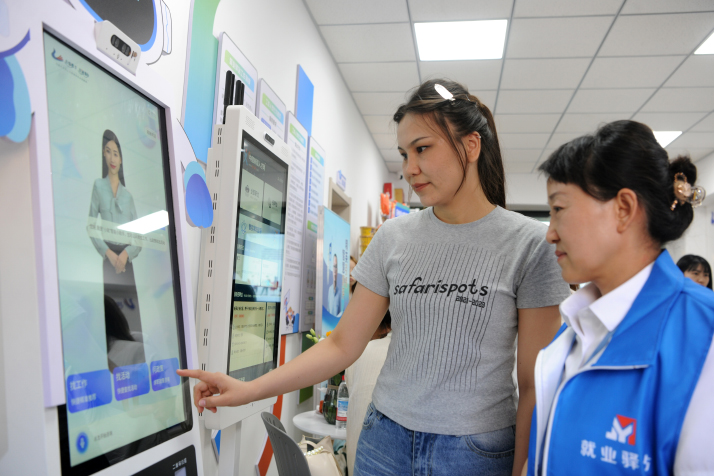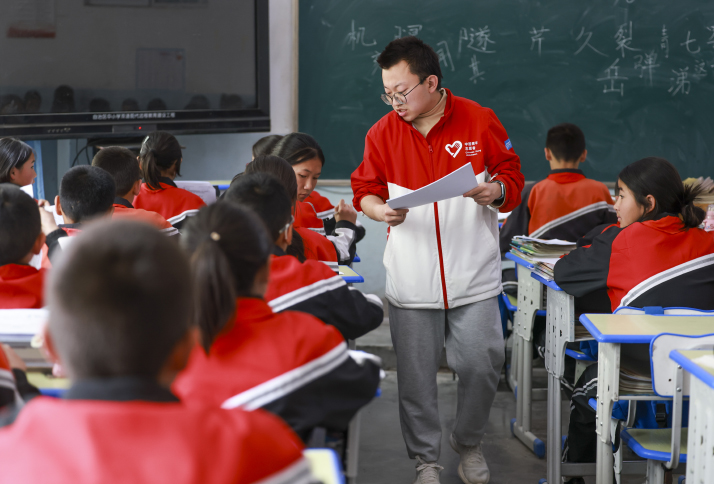| Xinjiang Today |
| Employment push | |
|
|
 College graduates review job information at a career fair at Xinjiang Agricultural University in Urumqi on May 7 (VCG)
A job fair of Xinjiang University buzzed with energy as students, eager to launch their careers, navigated the crowded aisles.
"I hope to find more job opportunities through this job fair," said Pan Yue, a graduating student in the university, his voice filled with anticipation as he submitted carefully prepared resumes. Xinjiang University held a "100-Day Sprint" recruitment fair for its graduating class on June 18. The event drew 86 companies from an array of sectors, including information technology, education, finance and manufacturing, offering graduates over 1,880 positions. The recruitment fair also featured a livestreaming area, displaying real-time recruitment information so students unable to attend in person could access job details. This year will see the university confer degrees upon more than 4,700 undergraduates and 4,100 postgraduates. The large number of university graduates, combined with a limited supply of available positions, has significantly increased the pressure on university graduates to find employment. This recruitment fair represents just one component of Xinjiang University's comprehensive efforts to support graduates during this pivotal time. Similar events have been organized regularly over the past three months.  A job seeker (left) inquires about employment policies in the policy advisory area of Xinjiang's 2025 Spring Job Fair for College Graduates, held at the Xinjiang International Exhibition Center in Urumqi on March 2 (XINHUA)
Encouragingly, data show that the employment outlook for Xinjiang's university students is more favorable than the national average. In 2024, the first-time employment rate, which measures how many students successfully secured jobs right after graduation, remained steady at around 95 percent for Xinjiang college graduates. This stands in sharp contrast with the national first-time employment rate of 55.5 percent, as reported by recruitment platform Zhaopin.com. Governments at all levels are actively working to support university graduates in their job searches. Qin Yajing, Director of the Tianshan District Employment Service Management Center in Urumqi, which co-organized the aforementioned recruitment fair, explained, "Through these practical measures, we aim to alleviate the employment challenges faced by graduates while simultaneously providing high-quality talent to meet the needs of enterprises." On April 12, five prefectures and cities in north Xinjiang—Karamay City, Tacheng Prefecture, Altay Prefecture, Bortala Mongolian Autonomous Prefecture and Shihezi City—formed an employment cooperation alliance. This alliance is designed to precisely match enterprises with job seekers and establish a regional employment service system that supports the high-quality development of Xinjiang's economy and society with skilled talent. That same day, the Karamay Municipal Human Resources and Social Security Bureau hosted a recruitment fair, attracting nearly 100 enterprises from the five prefectures and cities in north Xinjiang and around 300 graduating students from eight universities within the autonomous region. In addition, the bureau organized visits for university students to the Karamay Museum, Science and Technology Museum and Petroleum Memorial Square to help them know more about the city, and encouraged them to stay and work in Karamay. Since 2023, the Karamay Municipal Human Resources and Social Security Bureau has brought university graduates from across Xinjiang to Karamay for job-hunting opportunities in five separate groups, successfully attracting more than 2,200 graduates to work in the city.  A job seeker (left) uses an AI job search kiosk at an employment assistance center in Urumqi on June 13 (VCG)
Support for college graduates In a letter to graduating university students in 2025 on June 20, Xinjiang's Department of Human Resources and Social Security (XHRSSD) made two key pledges: "If you're still seeking employment, we're here to help. Register with your local public employment and talent service center, state your employment needs, and access free public services like job information, career guidance and vocational training." "Aspiring entrepreneurs, we'll build a platform for you. Consult with entrepreneurial mentors to refine your ideas; apply for guaranteed loans, interest subsidies, tax incentives and entrepreneurial grants to ease the burden of starting a business; and leverage enterprise incubation bases for guidance on business development, project promotion and incubation services." To boost employment for college students, the XHRSSD has established multiple recruitment service platforms, enabling job seekers to register and search for available opportunities. According to the XHRSSD, Xinjiang has maintained a stable level of recruitment in public institutions and state-owned enterprises, while expanding the Three Supports and One Assistance program. This national initiative promotes rural revitalization by deploying young professionals to support education, agriculture, medical care and rural revitalization in underserved areas. On June 7, the XHRSSD released 7,431 internship positions, including 5,389 specifically designated for college graduates. In July, the XHRSSD will launch an employment assistance campaign targeting fresh college graduates who have not yet found employment. In collaboration with education departments, the XHRSSD will actively offer employment information and services to job-seeking graduates, ensuring that they know where to turn for help. The XHRSSD says it will assess the needs of registered unemployed graduates and provide tailored support such as career guidance, job recommendations, training and internship opportunities. For graduates from financially challenged families, dedicated personnel from human resources and social security departments at all levels will assign pairing assistance to help them find employment as quickly as possible. Beyond fresh college graduates, the XHRSSD also recognizes the importance of supporting employment for other key groups. According to official statistics, Xinjiang's labor force totaled approximately 17 million at the end of 2024, representing 65.6 percent of the region's total population. The majority of this workforce has not received higher education. Individuals holding associate's degrees or higher make up only 5.1 percent of the total labor force, while those with junior and senior high school education account for 40.3 percent. To promote vocational skills development and enhance workers' employability, the XHRSSD issued the "Skills Illuminate the Future" Training Campaign Implementation Plan on June 11. According to the plan, from late 2025 to 2027, the autonomous region will prioritize expanding employment opportunities by providing targeted vocational training for key groups, including registered unemployed individuals and those facing difficulties in finding employment.  A teacher conducts a lesson at a primary school in Halajun Township, Kezilesu (Kizilsu) Kirgiz Autonomous Prefecture, on April 23 (XINHUA)
Prioritizing employment Employment is fundamental to people's livelihoods, as stated in the Government Work Report during the national legislative session in Beijing this March. Governments at all levels are making employment a central focus. Since the beginning of the year, Xinjiang has pursued high-quality full employment, resulting in the creation of 266,000 new urban jobs between January and May, reflecting a stable overall employment situation in the region. According to the XHRSSD, Xinjiang is strengthening its employment-first policies and expanding job opportunities in 2025. In collaboration with departments overseeing reform, industry and information technology, the XHRSSD has conducted evaluations to assess the employment impact of public investments and major projects. These evaluations form part of a newly established mechanism designed to ensure that key policies and projects contribute more effectively to job creation. The XHRSSD is focusing on generating employment in areas such as key industries, grassroots positions and micro, small and medium enterprises, with the goal of creating over 450,000 jobs in 2025. Targeted areas include new quality productive forces, emerging consumption trends and major engineering and construction projects throughout 2025. New quality productive forces, introduced in 2023, represent advanced productivity beyond traditional economic growth models. They are characterized by hi-tech, high-efficiency and high-quality development aligned with principles of innovation, coordination, green practices, openness and inclusive growth. Significant efforts are also being made to ensure employment for key groups. The autonomous region has focused on rural labor employment by organizing job-matching activities within Xinjiang and across China as a whole. These initiatives have helped facilitate out-of-region employment for rural residents, contributing to increased household incomes. Continued support is provided to individuals facing employment challenges. Since the start of the year, these efforts have helped 140,000 unemployed individuals secure jobs. Comments to lanxinzhen@cicgamericas.com |
|
||||||||||||||||||||||||||||
|